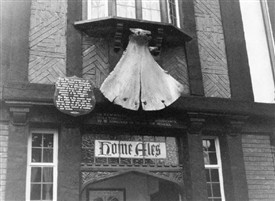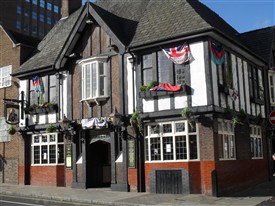The 'Royal Children' pub

A whale's shoulder blade formed the inn sign at the Royal Children pub for many years.
It is seen here in a photograph from 1971

The Royal Children pub, Nottingham
Photographed October 2013
Castle Gate, Nottingham
The Royal Children was listed in the first town directory of Nottingham in 1799, although its origins are known to be Medieval.
It is named for the children of Anne, daughter of King James II, and subsequently Queen Anne (reigned 1702-1714 - See below).
There is mention of a custom whereby, upon the birth of a royal child, all the regulars are given a glass of champagne.
The original pub sign was in the form of a shoulder blade of a whale which is still preserved within the pub (above the bar) to this day (the shoulder blade that is, not the entire whale!).
A plaque outsde the pub tells us that this was possibly the only inn sign of its kind in existence, and that it came into being "in a period shortly after James II when whale oil was introduced to take the place of candles".
The pub is said to have been one of the first to use oil lamps in Nottingham, and the innkeeper was also a retailer of whale oil to the people of the district.
Naming the pub
The pub is listed under this name in the earliest Nottingham trade directory of 1799.
The name is supposed to relate to the children of Anne, daughter of James II who, whilst staying at nearby Nottingham Castle in the 1680s, are said to have played with the children of the innkeeper.
This is the story recorded on the plaque displayed outside the inn (pictured, right)
This is considered highly improbable, but the inn sign perpetuates the story by presenting two well-dressed, blonde-headed royal children (a boy and girl) together with a smaller. more ordinarily dressed girl.
In their book The Inns & Pubs of Nottinghamshire (NCC, 1995 p.92), Gordon Wright and Brian J. Curtis explain why all this is historically improbable; although the princess did stay at Nottingham Castle for a short time in 1688, she had no surviving children at that time